Audit, Assurance, and Compliance: Individual Assignment Report
VerifiedAdded on 2020/02/24
|10
|1424
|48
Report
AI Summary
This individual assignment report focuses on audit, assurance, and compliance, providing a detailed analysis of financial statements. The report begins with an analysis of various financial ratios, including current ratio, quick ratio, and inventory turnover, evaluating their trends over a three-year period and assessing their audit implications. The second part of the report delves into inherent risks, identifying potential misstatements related to inventory valuation and e-book revenue recognition. The report highlights complexities in transaction recording and revenue allocation. The final section addresses fraud risks, specifically examining cash receipt processes and the implementation of a new IT system, along with their impact on the audit process. The report provides a thorough examination of audit procedures, risk assessment, and compliance considerations.
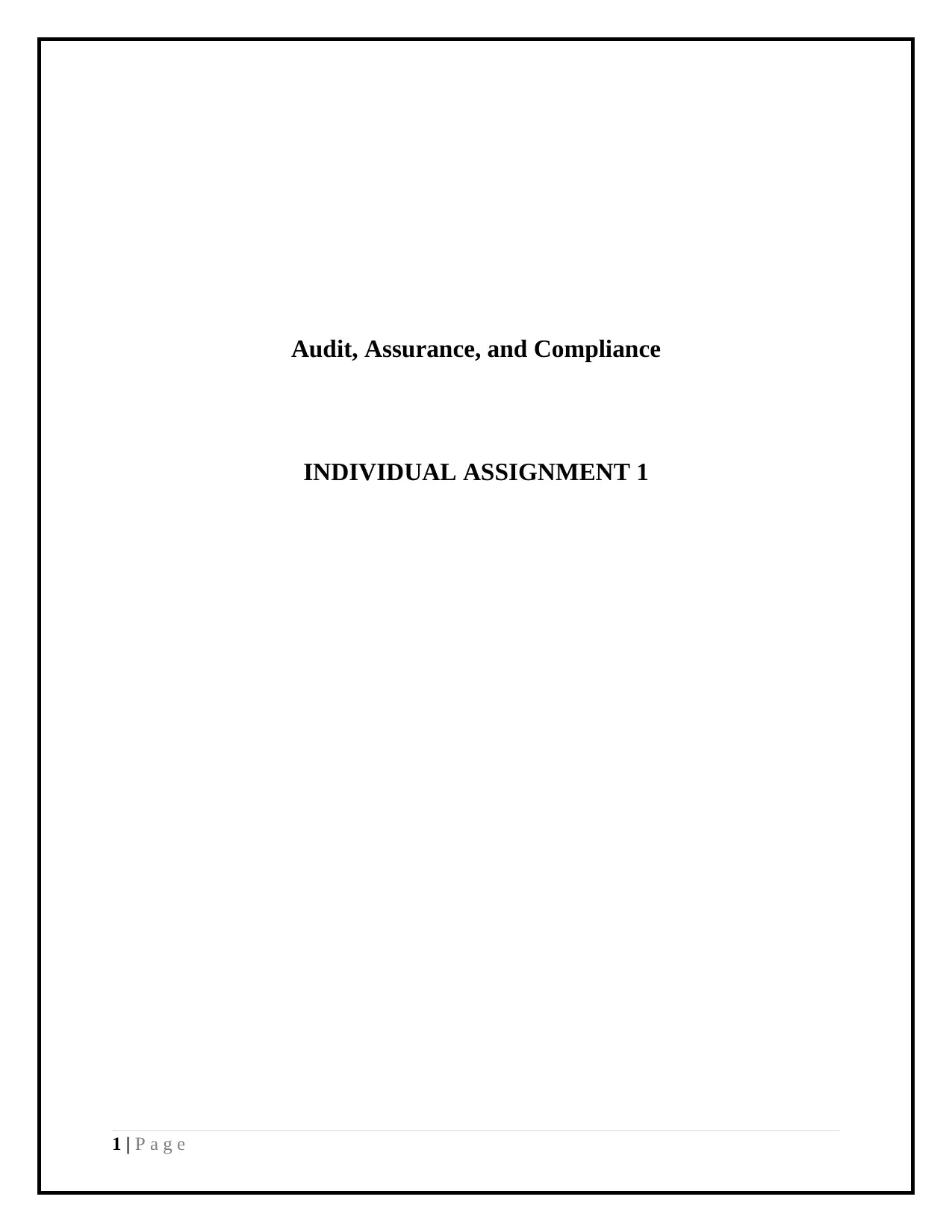
Audit, Assurance, and Compliance
INDIVIDUAL ASSIGNMENT 1
1 | P a g e
INDIVIDUAL ASSIGNMENT 1
1 | P a g e
Paraphrase This Document
Need a fresh take? Get an instant paraphrase of this document with our AI Paraphraser
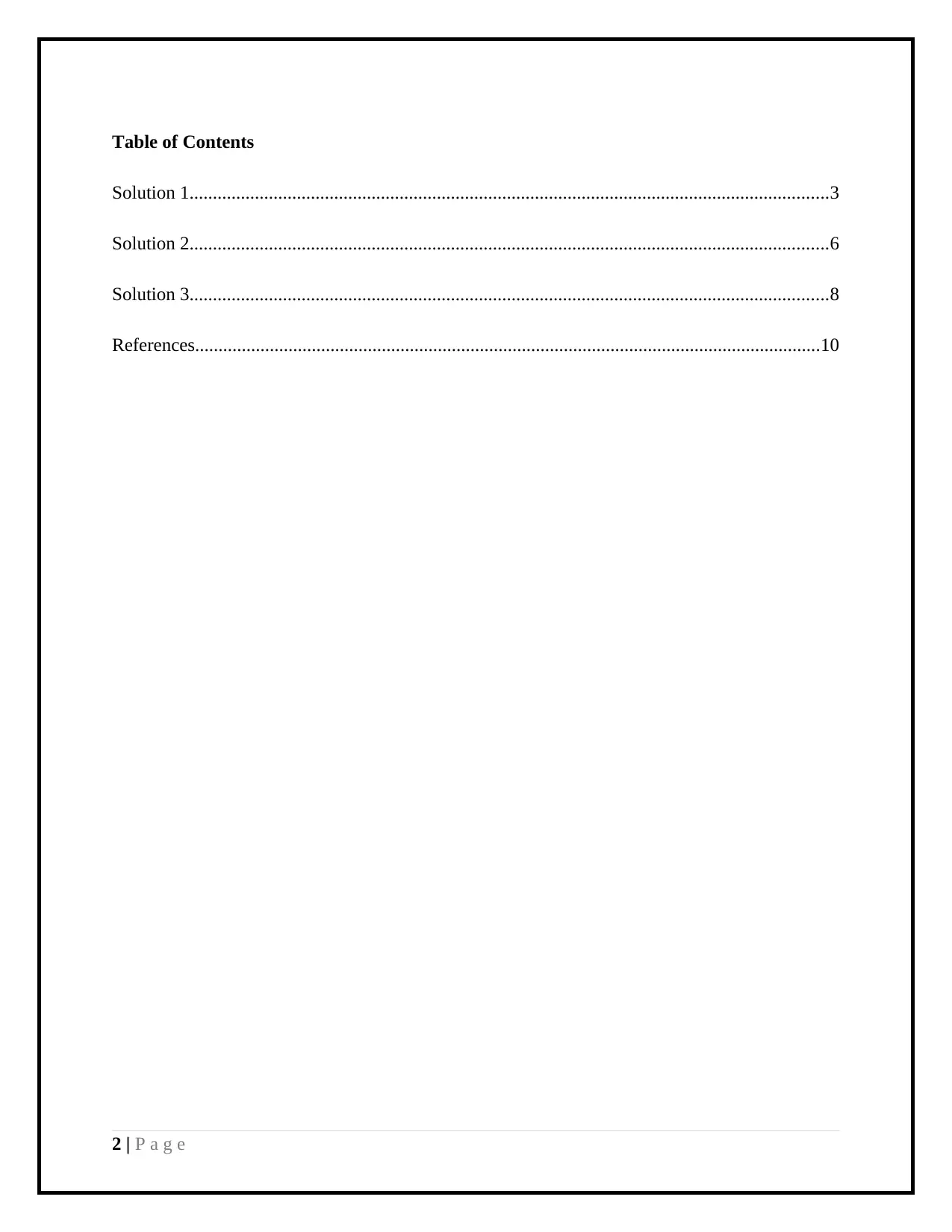
Table of Contents
Solution 1.........................................................................................................................................3
Solution 2.........................................................................................................................................6
Solution 3.........................................................................................................................................8
References......................................................................................................................................10
2 | P a g e
Solution 1.........................................................................................................................................3
Solution 2.........................................................................................................................................6
Solution 3.........................................................................................................................................8
References......................................................................................................................................10
2 | P a g e
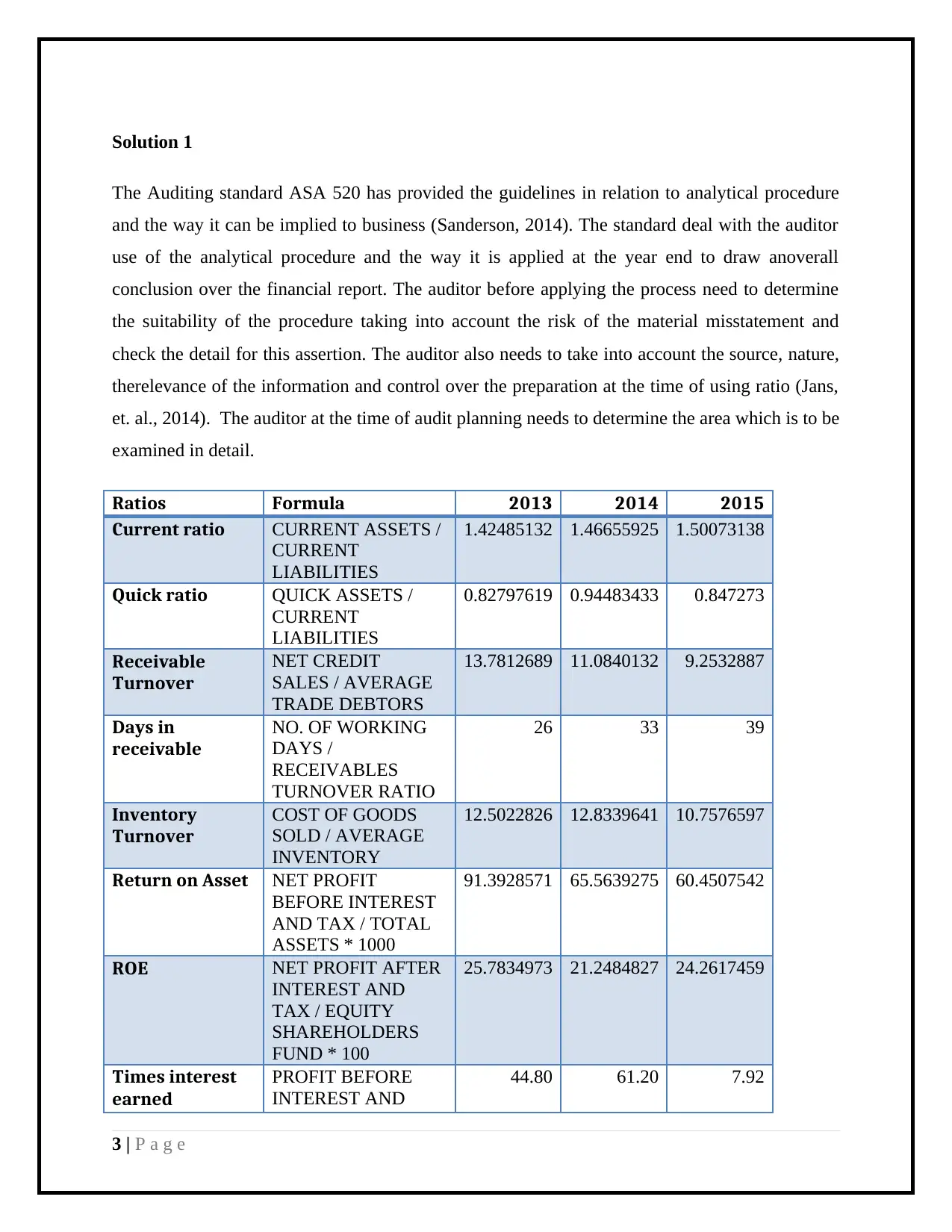
Solution 1
The Auditing standard ASA 520 has provided the guidelines in relation to analytical procedure
and the way it can be implied to business (Sanderson, 2014). The standard deal with the auditor
use of the analytical procedure and the way it is applied at the year end to draw anoverall
conclusion over the financial report. The auditor before applying the process need to determine
the suitability of the procedure taking into account the risk of the material misstatement and
check the detail for this assertion. The auditor also needs to take into account the source, nature,
therelevance of the information and control over the preparation at the time of using ratio (Jans,
et. al., 2014). The auditor at the time of audit planning needs to determine the area which is to be
examined in detail.
Ratios Formula 2013 2014 2015
Current ratio CURRENT ASSETS /
CURRENT
LIABILITIES
1.42485132 1.46655925 1.50073138
Quick ratio QUICK ASSETS /
CURRENT
LIABILITIES
0.82797619 0.94483433 0.847273
Receivable
Turnover
NET CREDIT
SALES / AVERAGE
TRADE DEBTORS
13.7812689 11.0840132 9.2532887
Days in
receivable
NO. OF WORKING
DAYS /
RECEIVABLES
TURNOVER RATIO
26 33 39
Inventory
Turnover
COST OF GOODS
SOLD / AVERAGE
INVENTORY
12.5022826 12.8339641 10.7576597
Return on Asset NET PROFIT
BEFORE INTEREST
AND TAX / TOTAL
ASSETS * 1000
91.3928571 65.5639275 60.4507542
ROE NET PROFIT AFTER
INTEREST AND
TAX / EQUITY
SHAREHOLDERS
FUND * 100
25.7834973 21.2484827 24.2617459
Times interest
earned
PROFIT BEFORE
INTEREST AND
44.80 61.20 7.92
3 | P a g e
The Auditing standard ASA 520 has provided the guidelines in relation to analytical procedure
and the way it can be implied to business (Sanderson, 2014). The standard deal with the auditor
use of the analytical procedure and the way it is applied at the year end to draw anoverall
conclusion over the financial report. The auditor before applying the process need to determine
the suitability of the procedure taking into account the risk of the material misstatement and
check the detail for this assertion. The auditor also needs to take into account the source, nature,
therelevance of the information and control over the preparation at the time of using ratio (Jans,
et. al., 2014). The auditor at the time of audit planning needs to determine the area which is to be
examined in detail.
Ratios Formula 2013 2014 2015
Current ratio CURRENT ASSETS /
CURRENT
LIABILITIES
1.42485132 1.46655925 1.50073138
Quick ratio QUICK ASSETS /
CURRENT
LIABILITIES
0.82797619 0.94483433 0.847273
Receivable
Turnover
NET CREDIT
SALES / AVERAGE
TRADE DEBTORS
13.7812689 11.0840132 9.2532887
Days in
receivable
NO. OF WORKING
DAYS /
RECEIVABLES
TURNOVER RATIO
26 33 39
Inventory
Turnover
COST OF GOODS
SOLD / AVERAGE
INVENTORY
12.5022826 12.8339641 10.7576597
Return on Asset NET PROFIT
BEFORE INTEREST
AND TAX / TOTAL
ASSETS * 1000
91.3928571 65.5639275 60.4507542
ROE NET PROFIT AFTER
INTEREST AND
TAX / EQUITY
SHAREHOLDERS
FUND * 100
25.7834973 21.2484827 24.2617459
Times interest
earned
PROFIT BEFORE
INTEREST AND
44.80 61.20 7.92
3 | P a g e
⊘ This is a preview!⊘
Do you want full access?
Subscribe today to unlock all pages.

Trusted by 1+ million students worldwide
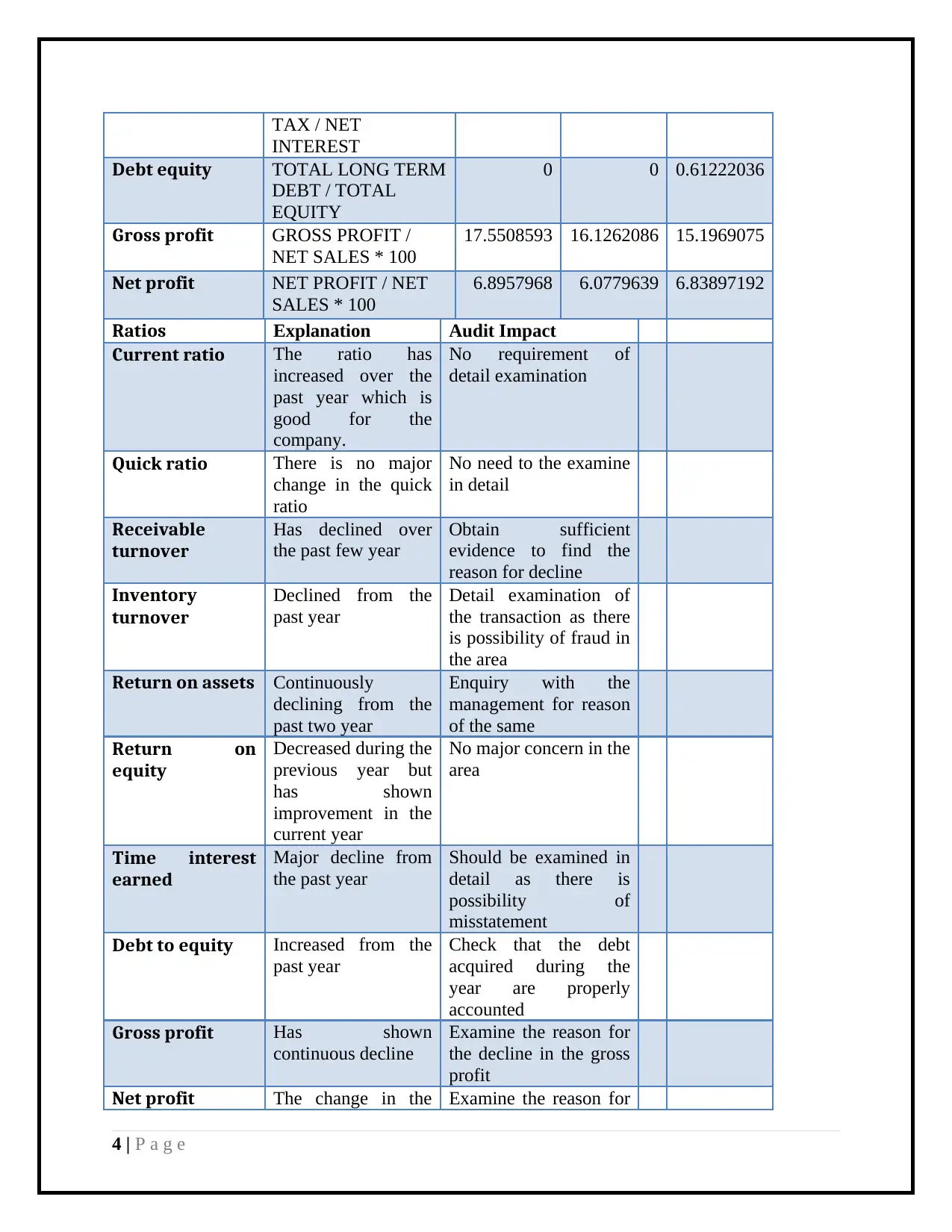
TAX / NET
INTEREST
Debt equity TOTAL LONG TERM
DEBT / TOTAL
EQUITY
0 0 0.61222036
Gross profit GROSS PROFIT /
NET SALES * 100
17.5508593 16.1262086 15.1969075
Net profit NET PROFIT / NET
SALES * 100
6.8957968 6.0779639 6.83897192
Ratios Explanation Audit Impact
Current ratio The ratio has
increased over the
past year which is
good for the
company.
No requirement of
detail examination
Quick ratio There is no major
change in the quick
ratio
No need to the examine
in detail
Receivable
turnover
Has declined over
the past few year
Obtain sufficient
evidence to find the
reason for decline
Inventory
turnover
Declined from the
past year
Detail examination of
the transaction as there
is possibility of fraud in
the area
Return on assets Continuously
declining from the
past two year
Enquiry with the
management for reason
of the same
Return on
equity
Decreased during the
previous year but
has shown
improvement in the
current year
No major concern in the
area
Time interest
earned
Major decline from
the past year
Should be examined in
detail as there is
possibility of
misstatement
Debt to equity Increased from the
past year
Check that the debt
acquired during the
year are properly
accounted
Gross profit Has shown
continuous decline
Examine the reason for
the decline in the gross
profit
Net profit The change in the Examine the reason for
4 | P a g e
INTEREST
Debt equity TOTAL LONG TERM
DEBT / TOTAL
EQUITY
0 0 0.61222036
Gross profit GROSS PROFIT /
NET SALES * 100
17.5508593 16.1262086 15.1969075
Net profit NET PROFIT / NET
SALES * 100
6.8957968 6.0779639 6.83897192
Ratios Explanation Audit Impact
Current ratio The ratio has
increased over the
past year which is
good for the
company.
No requirement of
detail examination
Quick ratio There is no major
change in the quick
ratio
No need to the examine
in detail
Receivable
turnover
Has declined over
the past few year
Obtain sufficient
evidence to find the
reason for decline
Inventory
turnover
Declined from the
past year
Detail examination of
the transaction as there
is possibility of fraud in
the area
Return on assets Continuously
declining from the
past two year
Enquiry with the
management for reason
of the same
Return on
equity
Decreased during the
previous year but
has shown
improvement in the
current year
No major concern in the
area
Time interest
earned
Major decline from
the past year
Should be examined in
detail as there is
possibility of
misstatement
Debt to equity Increased from the
past year
Check that the debt
acquired during the
year are properly
accounted
Gross profit Has shown
continuous decline
Examine the reason for
the decline in the gross
profit
Net profit The change in the Examine the reason for
4 | P a g e
Paraphrase This Document
Need a fresh take? Get an instant paraphrase of this document with our AI Paraphraser
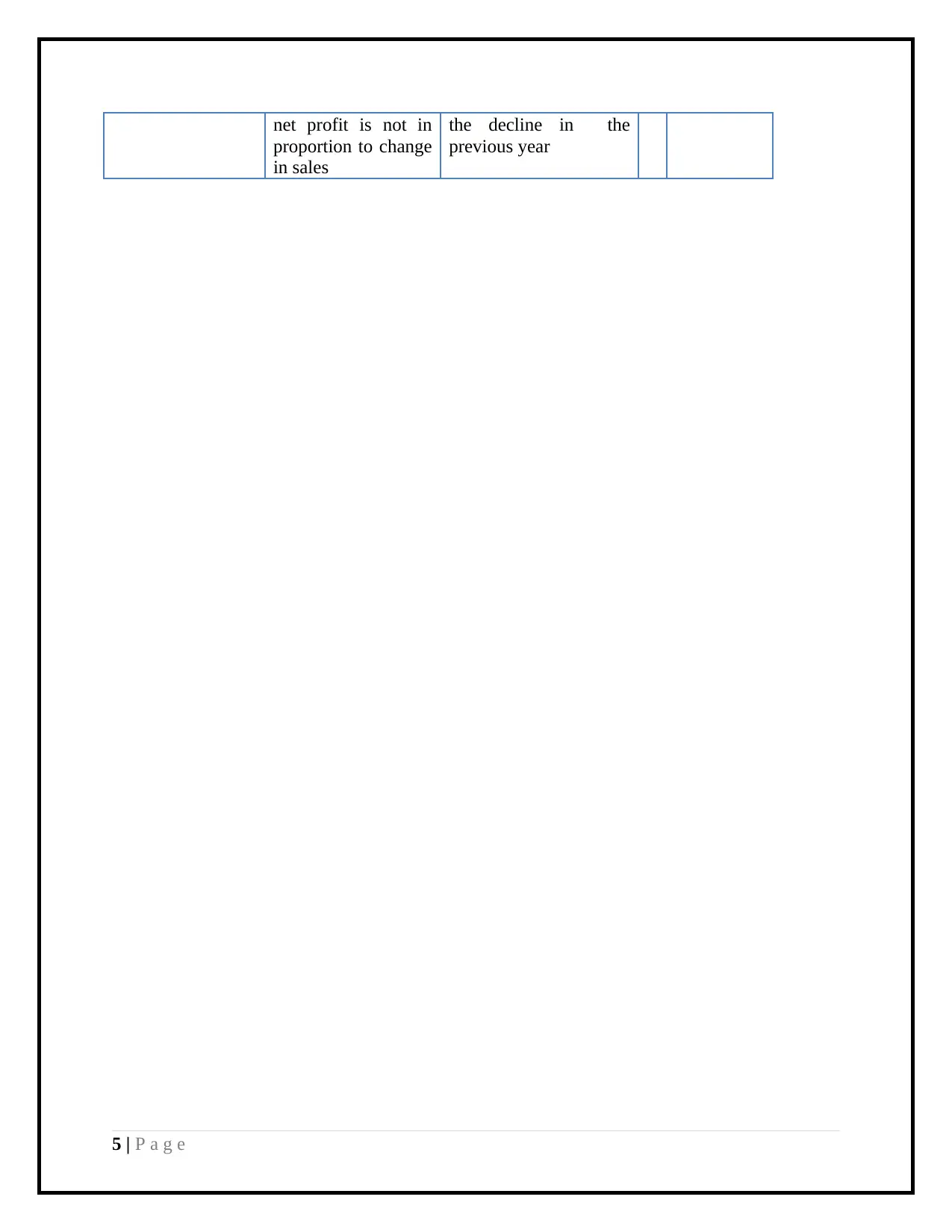
net profit is not in
proportion to change
in sales
the decline in the
previous year
5 | P a g e
proportion to change
in sales
the decline in the
previous year
5 | P a g e

Solution 2
The auditor needs to comply with the guidelines provided in ASA 200 at the time of identifying
the risk in relation to the audit of the DIPL. The inherent risk occurs due to amaterial
misstatement in the financial statement which may be due to error or omission and thereason
behind the same is other than the internal control system (Clikeman& Diaz, 2014). The inherent
risk is said to be high when there is thepossibility of misstatement in the financial statement and
occur due to complexity in recording the transaction. The auditor at the time of reporting should
focus on error free and inherent free risk reporting at the time of reporting to make anaccurate
decision.
Inherent risk Reasons for inherent risk Impact on material
misstatement
1. Inventory The DIPL acquire resources from
two different Australia and Asian
countries which create complexity at
the time recording the transaction
and may lead to misstatement due to
thedifference in theexchange rate
over the period of time. Also, the
company for the purpose of stock
taking closes its books of accounts
on 27th June which may lead to
many of the time unrecorded thus
leading to theinappropriate
recording of the inventory.
The material misstatement may
lead to thewrong valuation of
the inventory as the company
may failto track the inventory
which in transit which may lead
to undervaluation and
overvaluation of the inventory
thus affecting the reporting of
the financial statement
(Hematfar&Hemmati, 2013).
2. E-book
revenue
The other area where there is the
possibility of inherent risk is in
recognizing the revenue from E-
book. There may be thepossibility of
inherent risk as the storage fees are
recognized in the month when fees
are invoiced instead of the fact that
the fee is charged 12 months in
advance (Yoon, et. al., 2015).
The misstatement in the E-book
revenue will lead to improper
allocation of the fee over the
period as the company
recognizes the fee during the
period when payment is made
to the publisher.
6 | P a g e
The auditor needs to comply with the guidelines provided in ASA 200 at the time of identifying
the risk in relation to the audit of the DIPL. The inherent risk occurs due to amaterial
misstatement in the financial statement which may be due to error or omission and thereason
behind the same is other than the internal control system (Clikeman& Diaz, 2014). The inherent
risk is said to be high when there is thepossibility of misstatement in the financial statement and
occur due to complexity in recording the transaction. The auditor at the time of reporting should
focus on error free and inherent free risk reporting at the time of reporting to make anaccurate
decision.
Inherent risk Reasons for inherent risk Impact on material
misstatement
1. Inventory The DIPL acquire resources from
two different Australia and Asian
countries which create complexity at
the time recording the transaction
and may lead to misstatement due to
thedifference in theexchange rate
over the period of time. Also, the
company for the purpose of stock
taking closes its books of accounts
on 27th June which may lead to
many of the time unrecorded thus
leading to theinappropriate
recording of the inventory.
The material misstatement may
lead to thewrong valuation of
the inventory as the company
may failto track the inventory
which in transit which may lead
to undervaluation and
overvaluation of the inventory
thus affecting the reporting of
the financial statement
(Hematfar&Hemmati, 2013).
2. E-book
revenue
The other area where there is the
possibility of inherent risk is in
recognizing the revenue from E-
book. There may be thepossibility of
inherent risk as the storage fees are
recognized in the month when fees
are invoiced instead of the fact that
the fee is charged 12 months in
advance (Yoon, et. al., 2015).
The misstatement in the E-book
revenue will lead to improper
allocation of the fee over the
period as the company
recognizes the fee during the
period when payment is made
to the publisher.
6 | P a g e
⊘ This is a preview!⊘
Do you want full access?
Subscribe today to unlock all pages.

Trusted by 1+ million students worldwide
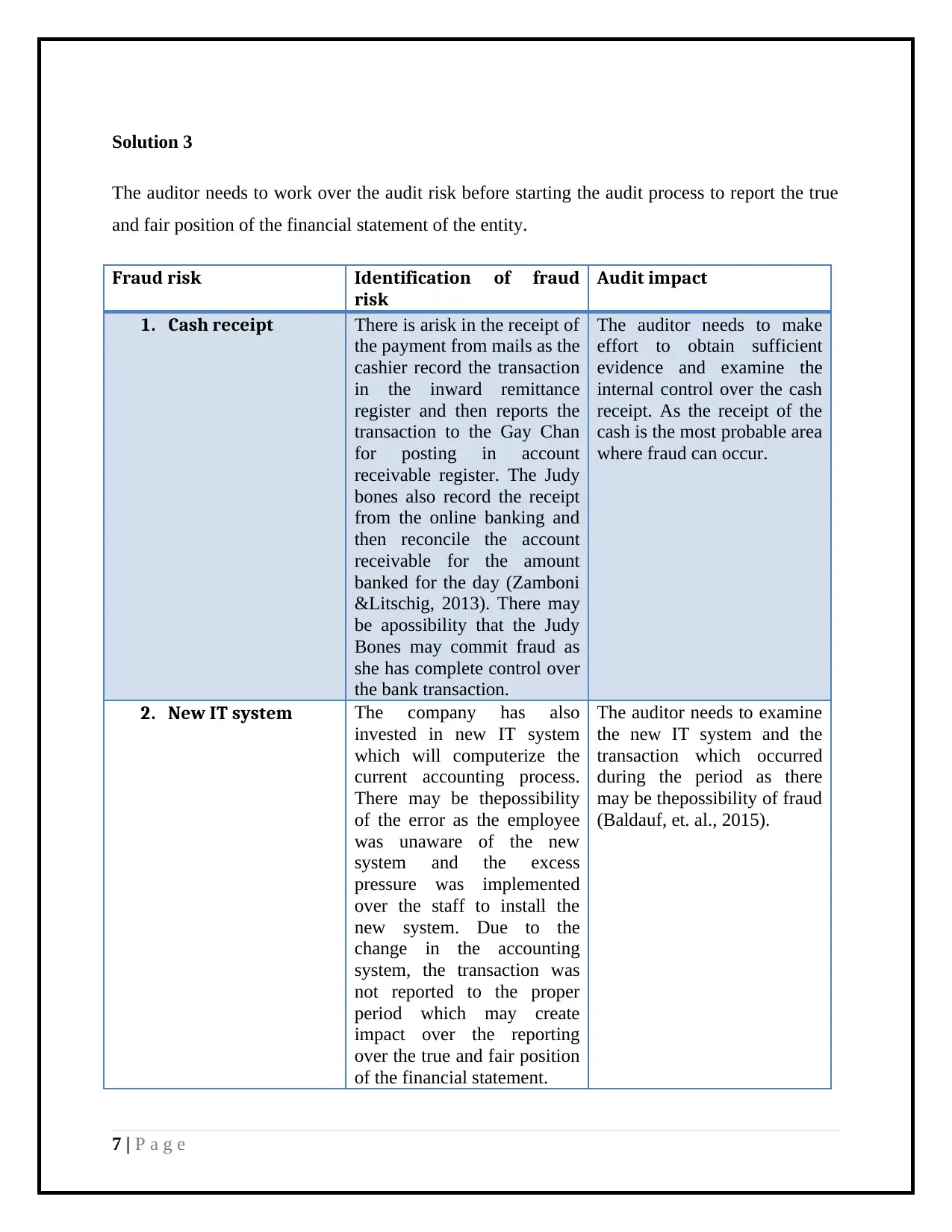
Solution 3
The auditor needs to work over the audit risk before starting the audit process to report the true
and fair position of the financial statement of the entity.
Fraud risk Identification of fraud
risk
Audit impact
1. Cash receipt There is arisk in the receipt of
the payment from mails as the
cashier record the transaction
in the inward remittance
register and then reports the
transaction to the Gay Chan
for posting in account
receivable register. The Judy
bones also record the receipt
from the online banking and
then reconcile the account
receivable for the amount
banked for the day (Zamboni
&Litschig, 2013). There may
be apossibility that the Judy
Bones may commit fraud as
she has complete control over
the bank transaction.
The auditor needs to make
effort to obtain sufficient
evidence and examine the
internal control over the cash
receipt. As the receipt of the
cash is the most probable area
where fraud can occur.
2. New IT system The company has also
invested in new IT system
which will computerize the
current accounting process.
There may be thepossibility
of the error as the employee
was unaware of the new
system and the excess
pressure was implemented
over the staff to install the
new system. Due to the
change in the accounting
system, the transaction was
not reported to the proper
period which may create
impact over the reporting
over the true and fair position
of the financial statement.
The auditor needs to examine
the new IT system and the
transaction which occurred
during the period as there
may be thepossibility of fraud
(Baldauf, et. al., 2015).
7 | P a g e
The auditor needs to work over the audit risk before starting the audit process to report the true
and fair position of the financial statement of the entity.
Fraud risk Identification of fraud
risk
Audit impact
1. Cash receipt There is arisk in the receipt of
the payment from mails as the
cashier record the transaction
in the inward remittance
register and then reports the
transaction to the Gay Chan
for posting in account
receivable register. The Judy
bones also record the receipt
from the online banking and
then reconcile the account
receivable for the amount
banked for the day (Zamboni
&Litschig, 2013). There may
be apossibility that the Judy
Bones may commit fraud as
she has complete control over
the bank transaction.
The auditor needs to make
effort to obtain sufficient
evidence and examine the
internal control over the cash
receipt. As the receipt of the
cash is the most probable area
where fraud can occur.
2. New IT system The company has also
invested in new IT system
which will computerize the
current accounting process.
There may be thepossibility
of the error as the employee
was unaware of the new
system and the excess
pressure was implemented
over the staff to install the
new system. Due to the
change in the accounting
system, the transaction was
not reported to the proper
period which may create
impact over the reporting
over the true and fair position
of the financial statement.
The auditor needs to examine
the new IT system and the
transaction which occurred
during the period as there
may be thepossibility of fraud
(Baldauf, et. al., 2015).
7 | P a g e
Paraphrase This Document
Need a fresh take? Get an instant paraphrase of this document with our AI Paraphraser

8 | P a g e
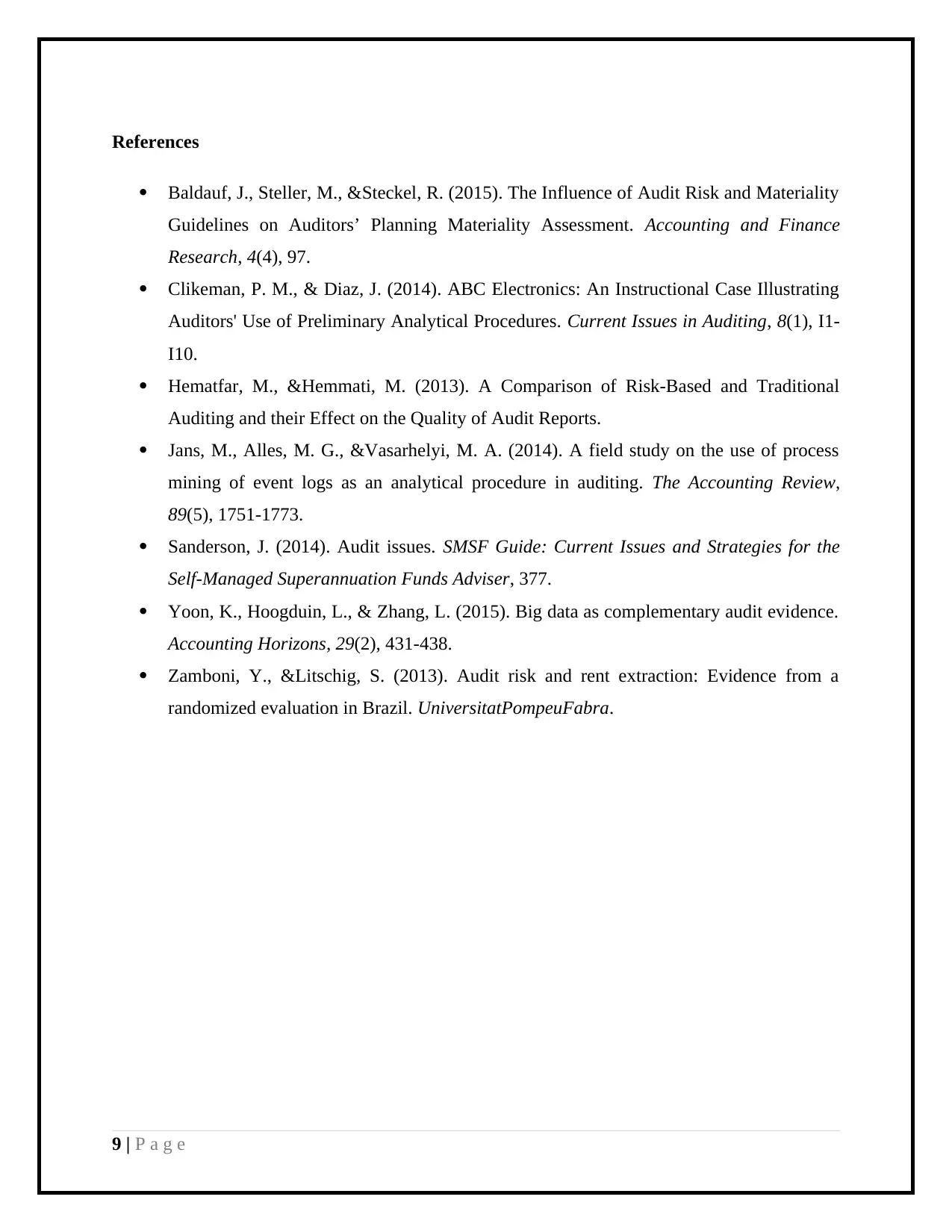
References
Baldauf, J., Steller, M., &Steckel, R. (2015). The Influence of Audit Risk and Materiality
Guidelines on Auditors’ Planning Materiality Assessment. Accounting and Finance
Research, 4(4), 97.
Clikeman, P. M., & Diaz, J. (2014). ABC Electronics: An Instructional Case Illustrating
Auditors' Use of Preliminary Analytical Procedures. Current Issues in Auditing, 8(1), I1-
I10.
Hematfar, M., &Hemmati, M. (2013). A Comparison of Risk-Based and Traditional
Auditing and their Effect on the Quality of Audit Reports.
Jans, M., Alles, M. G., &Vasarhelyi, M. A. (2014). A field study on the use of process
mining of event logs as an analytical procedure in auditing. The Accounting Review,
89(5), 1751-1773.
Sanderson, J. (2014). Audit issues. SMSF Guide: Current Issues and Strategies for the
Self-Managed Superannuation Funds Adviser, 377.
Yoon, K., Hoogduin, L., & Zhang, L. (2015). Big data as complementary audit evidence.
Accounting Horizons, 29(2), 431-438.
Zamboni, Y., &Litschig, S. (2013). Audit risk and rent extraction: Evidence from a
randomized evaluation in Brazil. UniversitatPompeuFabra.
9 | P a g e
Baldauf, J., Steller, M., &Steckel, R. (2015). The Influence of Audit Risk and Materiality
Guidelines on Auditors’ Planning Materiality Assessment. Accounting and Finance
Research, 4(4), 97.
Clikeman, P. M., & Diaz, J. (2014). ABC Electronics: An Instructional Case Illustrating
Auditors' Use of Preliminary Analytical Procedures. Current Issues in Auditing, 8(1), I1-
I10.
Hematfar, M., &Hemmati, M. (2013). A Comparison of Risk-Based and Traditional
Auditing and their Effect on the Quality of Audit Reports.
Jans, M., Alles, M. G., &Vasarhelyi, M. A. (2014). A field study on the use of process
mining of event logs as an analytical procedure in auditing. The Accounting Review,
89(5), 1751-1773.
Sanderson, J. (2014). Audit issues. SMSF Guide: Current Issues and Strategies for the
Self-Managed Superannuation Funds Adviser, 377.
Yoon, K., Hoogduin, L., & Zhang, L. (2015). Big data as complementary audit evidence.
Accounting Horizons, 29(2), 431-438.
Zamboni, Y., &Litschig, S. (2013). Audit risk and rent extraction: Evidence from a
randomized evaluation in Brazil. UniversitatPompeuFabra.
9 | P a g e
⊘ This is a preview!⊘
Do you want full access?
Subscribe today to unlock all pages.

Trusted by 1+ million students worldwide

10 | P a g e
1 out of 10
Related Documents
Your All-in-One AI-Powered Toolkit for Academic Success.
+13062052269
info@desklib.com
Available 24*7 on WhatsApp / Email
![[object Object]](/_next/static/media/star-bottom.7253800d.svg)
Unlock your academic potential
Copyright © 2020–2025 A2Z Services. All Rights Reserved. Developed and managed by ZUCOL.





